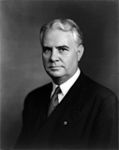| |||||||||||||||||
| |||||||||||||||||
 County results Bricker: 50–60% 60–70% 70–80% Huffman: 50–60% | |||||||||||||||||
| |||||||||||||||||
| Elections in Ohio |
|---|
 |
The 1946 United States Senate elections in Ohio was held on November 5, 1946, alongside a concurrent special election to the same seat.
Contents
- Background
- Democratic primary
- Candidates
- Results
- General election
- Results 2
- Special election
- See also
- References
Former Republican Governor of Ohio and 1944 nominee for the U.S. vice presidency John W. Bricker defeated Democratic interim senator James W. Huffman, who had been appointed to fill the vacant seat left by Supreme Court Justice Harold Hitz Burton. In a concurrent special election to finish Burton's unexpired term, Republican Kingsley Taft defeated Henry P. Webber.

